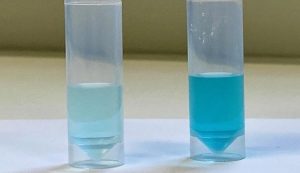Assessment of risk for a given disease and the diagnosis of diseases is often based on assays detecting biomarkers. Antibody-based biomarker-assays for diseases such as prostate cancer are often ambiguous and biomarker proteins are frequently also elevated for reasons that are unspecific.
Kulpakko et al. have opted to use luminescence modulating phages for the analysis of known acute inflammatory response biomarker CRP (C-reactive protein) and biomarkers of prostate cancer in urine samples.

Illustration of quencher binding properties of biopanned phages.
Firstly, CRP was used to simulate the detection process in a controlled chemical environment. Secondly, they tried to classify more challenging lethal prostate cancer samples from control samples.
The unique method used utilizes a special biopanning process in order to create special phages capable of capturing a dye necessary for detection and potential biomarkers. As the biomarker-molecules interfere with the phages, dye is repelled from the phage network resulting in an altered reporter luminescence. These changes can be observed with an absorbance reader and even with the naked eye. The simple method could present an alternative for screening of disease biomarkers.
For prostate cancer urine samples, the method achieved a sensitivity of 80% and specificity of 75% to detect Grade Group 4 and 5 prostate cancer.
Targeting Phage Therapy 2023 will introduce you to the potential of phages in detecting and diagnosing diseases. Secure a place.
Targeting Phage Therapy 2023
6th World Conference
June 1-2, 2023 – Paris, France
